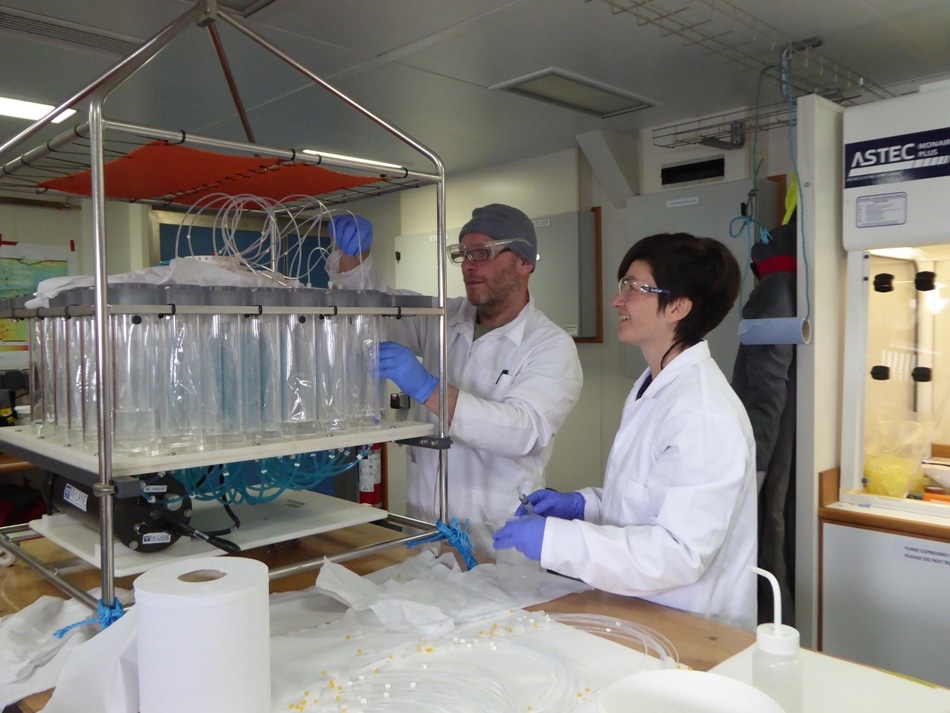Jun 30 2017
The crew of the Royal Research Ship Discovery, a scientific research vessel of the United Kingdom, recently deployed high-technology biogeochemical sensors onto existing ‘Overturning in the Subpolar North Atlantic Program’ (OSNAP) moorings in the Rockall Trough, a major deep-water area in the North Atlantic Ocean.
 John Beaton and Sharon McNeill (both from SAMS) setting up the automated water sampler on board RRS Discovery ©Penny Holliday (NOC Southampton)
John Beaton and Sharon McNeill (both from SAMS) setting up the automated water sampler on board RRS Discovery ©Penny Holliday (NOC Southampton)
By taking continuous measurements in this important yet remote location, the sensors will contribute much needed long-term biogeochemical data to further our understanding of the interactions occurring in our ocean.
The North Atlantic Subpolar Gyre, located in the North Atlantic subpolar region, is a large system of rotating ocean currents which forms a key component of the global climate system. In this region, the ocean warms the atmosphere (keeping northern Europe relatively mild) and atmospheric carbon dioxide is drawn into the deep ocean. The flow of energy and elements through the North Atlantic Ocean ultimately drives patterns of marine biodiversity at the ocean basin scale.
OSNAP is an international programme designed to provide a continuous record of physical ocean properties in the subpolar North Atlantic through an array situated on moorings which cross the Atlantic. The newly deployed equipment consists of sensors to additionally measure levels of nutrients, oxygen and pH in the Rockall Trough. A Remote Access Sampler (RAS) will simultaneously collect samples of seawater to validate and complement the automatically recorded data from the sensors.
As Professor Stuart Cunningham, from the Scottish Association for Marine Science (SAMS) explains, adding these new sensors to the existing infrastructure is an important step: “So far, only the physical parameters of ocean circulation data can be measured at the OSNAP array. Combining this data with the new biogeochemical measurements will, for the first time, give us a long time-series of changes of ocean currents, nutrient concentrations and more. This will be a big advance in our ability to understand the interactions of ocean physics with ocean ecosystems, particularly the cold-water coral systems of the Atlantic.”
This work was undertaken as part of the multidisciplinary EU-funded Horizon 2020 ATLAS project which aims to improve our understanding of the complexity of deep-sea ecosystems, and to predict future shifts and vulnerabilities of these ecosystems and their associated species. For more information on ATLAS, please visit: www.eu-atlas.org.
The biogeochemical sensors that have been deployed are not new developments in themselves. However, as Prof Cunningham explains, “We are using them in a novel way. Combining biogeochemistry on this large physics array is ground breaking! By adding new observations of biogeochemical properties to existing large scale observing infrastructures we can make biogeochemical measurements at broader scales, matching the current physical observations. As a result, the possibilities and implications for understanding the critical processes occurring in our oceans are vast.”
Implementing key agreements to protect biodiversity and support adaptive ocean management requires improved knowledge on the Atlantic Ocean basin scale. ATLAS will contribute by enhancing the purpose-built trans-Atlantic array to deepen our understanding of the importance of ocean currents. Improved knowledge gained through the use of this unique basin scale infrastructure will help predicting ecosystem tipping points and understanding the link between ocean currents, species distribution and connectivity. This will, in turn, drive forward an ambitious new decision support tool for integrated Maritime Spatial Planning (MSP) of the Atlantic Ocean.